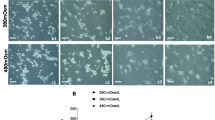Abstract
Evaluating chondrocytes in situ to document the effectiveness of cartilage preservation techniques has proven exceedingly difficult. This study was conducted to determine the effectiveness of WST-1 on porcine chondrocytes in situ after cooling to −10°C (without ice formation) compared to membrane integrity stains (MIS). Osteochondral dowels (10 mm in diameter) were harvested from sexually mature pigs within 24 h of sacrifice and randomized into three groups: (1) untreated control, (2) one day storage at −10°C (in cryoprotectant solution to prevent ice formation), and (3) seven day storage at −10°C (in cryoprotectant solution). Fluorescent MISs (Syto 13 and ethidium bromide) were used on 70 μm slices. Representative images were digitized and green and red pixel numbers determined the percent recovery of intact cells. Mitochondrial activity (WST-1) was determined using 20 slices of 70 μm thickness per sample to obtain reliable readings using a spectrophotometer at 450 nm. All samples underwent repeated measures of membrane integrity and metabolic activity obtained after 0, 3, 24, 48, 72, and 144 h incubation in growth media. WST-1 consistently overestimated cell recovery with results greater than fresh controls. After hypothermic storage for 7 days, the WST-1 measurement demonstrated decreased mitochondrial activity that recovered by 48 h. MIS was most accurate when “absolute” cell recovery was compared to original controls, taking into account cell density. In conclusion, WST-1 can track metabolic activity of chondrocytes in situ over time but “absolute” cell recovery determined by MISs after 48 h incubation may be the most accurate determination of the number of live chondrocytes in situ.


Similar content being viewed by others
Abbreviations
- AC:
-
articular cartilage
- ANOVA:
-
analysis of variance
- CGM:
-
chondrocyte growth medium
- EB:
-
ethidium bromide
- MIS:
-
membrane integrity stain
- OCD:
-
osteochondral dowel
- PBS:
-
phosphate buffered saline
- SPSS:
-
statistical package for the social sciences
References
Aubin PP, Cheah HK, Davis AM, Gross AE (2001) Long-term followup of fresh femoral osteochondral allografts for posttraumatic knee defects. Clin Orthop 391(Suppl):S318–S327
Ball ST, Amiel D, Williams SK, Tontz W, Chen AC, Sah RL, Bugbee WD (2004) The effects of storage on fresh human osteochondral allografts. Clin Orthop Relat Res 418:246–252
Bravo D, Rigley TH, Gibran N, Strong DM, Newman-Gage H (2000) Effect of storage and preservation methods on viability in transplantable human skin allografts. Burns 26(4):367–378
Bugbee WD, Convery FR (1999) Osteochondral allograft transplantation. Clin Sports Med 18(1):67–75
De Smet AA, Ilahi OA, Graf BK (1997) Untreated osteochondritis dissecans of the femoral condyles: prediction of patient outcome using radiographic and MR findings. Skeletal Radiol 26(8):463–467
Gross AE, Agnidis Z, Hutchison CR (2001) Osteochondral defects of the talus treated with fresh osteochondral allograft transplantation. Foot Ankle Int 22(5):385–391
Hangody L, Feczko P, Bartha L, Bodo G, Kish G (2001) Mosaicplasty for the treatment of articular defects of the knee and ankle. Clin Orthop 391(Suppl):S328–S336
Jackson DW, Simon TM, Aberman HM (2001) Symptomatic articular cartilage degeneration: the impact in the new millennium. Clin Orthop 391(Suppl):S14–25
Jomha NM, Anoop PC, Elliott JAW, Bagnall K, McGann LE (2003) Validation and reproducibility of computerised cell-viability analysis of tissue slices. BMC Musculoskelet Disord 4(1):5
Jomha NM, Law GK, McGann LE (2006) Storage of porcine articular cartilage at high subzero temperatures. Cell Tissue Bank 7(1):55–60
Mankin HJ, Mow VC, Buckwalter JA, Iannotti JP, Ratcliffe A (1994) Form and function of articular cartilage. S. R. Simon. Orthopaedic Basic Science. Chicago, p 1–44
McGann LE, Acker JP (1997) Cryopreservation. In: LH T-P (ed) Organ procurement and preservation for transplantation 2nd edn. Springer, Heidelberg, pp 47–66
McGann LE, Yang HY, Walterson M (1988) Manifestations of cell damage after freezing and thawing. Cryobiology 25(3):178–185
Pegg DE (1989) Viability assays for preserved cells, tissues, and organs. Cryobiology 26(3):212–231
Pegg DE, Wusteman MC, Wang L (2006) Cryopreservation of articular cartilage 1: Conventional cryopreservation methods. Cryobiology 52(3):335–346
Rohde RS, Studer RK, Chu CR (2004) Mini-pig fresh osteochondral allografts deteriorate after 1 week of cold storage. Clin Orthop Relat Res 427:226–233
Targeting arthritis: Public health takes action. Volume 2002: Center for disease control and prevention. Avail at http://www.cdc.gov/nccdphp/art-aag.htm
Tontz WL Jr, Bugbee WD, Brage ME (2003) Use of allografts in the management of ankle arthritis. Foot Ankle Clin 8(2):361–373 xi
Williams RJ 3rd, Dreese JC, Chen CT (2004) Chondrocyte survival and material properties of hypothermically stored cartilage: an evaluation of tissue used for osteochondral allograft transplantation. Am J Sports Med 32(1):132–139
Williams SK, Amiel D, Ball ST, Allen RT, Wong VW, Chen AC, Sah RL, Bugbee WD (2003) Prolonged storage effects on the articular cartilage of fresh human osteochondral allografts. J Bone Joint Surg Am 85A(11):2111–2120
Acknowledgements
The authors would like to acknowledge Sturgeon Valley Pork Ltd for supplying the pig joints. The authors acknowledge Dr. Lauren Beaupre for statistical analysis. JAW Elliott holds a Canada Research Chair in Interfacial Thermodynamics. This research was funded by the Canadian Institutes of Health Research.
Author information
Authors and Affiliations
Corresponding author
Rights and permissions
About this article
Cite this article
Jomha, N.M., Elliott, J.A.W., Law, G.K. et al. Evaluation of chondrocyte survival in situ using WST-1 and membrane integrity stains. Cell Tissue Banking 8, 179–186 (2007). https://doi.org/10.1007/s10561-006-9028-6
Received:
Accepted:
Published:
Issue Date:
DOI: https://doi.org/10.1007/s10561-006-9028-6




